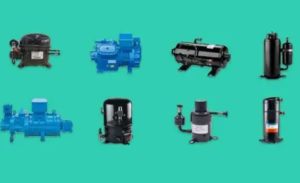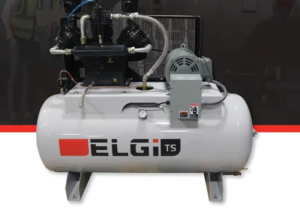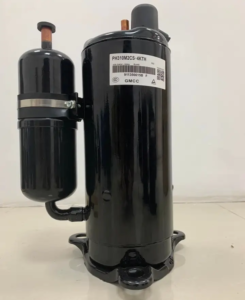Compressors are used in numerous industries and are an essential component of machinery used in various applications. From manufacturing plants to construction sites, compressors are responsible for compressing air or gas, converting mechanical energy into potential energy, and enabling the operation of various tools and equipment.
In simple terms, compressors are devices that increase the pressure of air or gas by reducing its volume. This process allows for the storage and transportation of pressurized air, which is utilized in a multitude of industrial processes. Whether it’s powering pneumatic tools, operating industrial machinery, or facilitating the cooling and refrigeration systems, compressors are indispensable across a wide range of sectors.
The importance of compressors in machinery cannot be overstated. They provide the necessary power and pressure required to ensure smooth and efficient operations. By compressing air or gas, compressors enable the functioning of vital equipment such as pumps, motors, and turbines. Additionally, they are also utilized in applications like air conditioning, ventilation, and refrigeration.
There are different types of compressors, and each type has distinct characteristics, advantages, and limitations, making it essential to choose the most suitable option based on factors such as required pressure levels, flow rates, and operating conditions.
In this post, we will talk about into various types of compressors commonly used in machinery. From positive displacement compressors like reciprocating and rotary compressors to dynamic compressors such as centrifugal and axial flow compressors, we will explore their working principles, applications, and notable features.
Compression is the process of reducing the volume of a gas or fluid by increasing its pressure. This principle is widely used in various industries, such as manufacturing, construction, and automotive.
The basic concept behind compression involves trapping a gas or fluid in a confined space and then applying force to reduce its volume. As the volume decreases, the pressure of the gas or fluid increases. This increase in pressure allows for the efficient storage or transportation of the compressed substance.
There are two main types of compression: positive displacement and dynamic compression. Positive displacement compressors work by trapping a fixed volume of gas or fluid and then reducing its volume by mechanical means. This type of compression is commonly used for applications that require a constant and steady flow of compressed air or fluid.
On the other hand, dynamic compressors use high-speed rotating impellers or blades to generate kinetic energy, which is then converted into pressure energy. This type of compression is ideal for situations where a large volume of gas or fluid needs to be compressed continuously, such as in large-scale industrial processes.
It is important to note that different types of compressors utilize different mechanisms to achieve compression. Some common types include reciprocating compressors, rotary screw compressors, centrifugal compressors, and axial compressors. Each type has its own advantages and limitations, making it crucial to understand their specific applications and performance characteristics.
By grasping the basic principles of compression, you can better appreciate the functionality and capabilities of the various types of compressors available. This understanding will help you make informed decisions when selecting the most suitable compressor for your specific machinery and operational requirements.
Reciprocating Compressors
Reciprocating compressors are one of the most commonly used types of compressors in various industries. These compressors operate by using a piston-cylinder mechanism to compress and deliver air or gas. They are known for their reliability, efficiency, and versatility, making them suitable for a wide range of applications.
One of the key features of reciprocating compressors is their ability to deliver high-pressure output. This makes them ideal for applications that require intense compression, such as powering pneumatic tools, filling gas cylinders, or providing air supply for industrial processes. Reciprocating compressors are also capable of handling a wide range of gas compositions, making them suitable for different industries, including oil and gas, manufacturing, and construction.
One of the main advantages of reciprocating compressors is their relatively compact size. This makes them suitable for installations where space is limited or where portability is required. Additionally, reciprocating compressors are known for their durability and long service life, especially when properly maintained. This makes them a cost-effective choice for businesses looking for reliable and long-lasting compression solutions.
Another advantage of reciprocating compressors is their ability to provide variable speed control. This feature allows operators to adjust the compressor’s output based on the demand, resulting in energy savings and improved efficiency. Furthermore, reciprocating compressors can be designed for multi-stage compression, which enhances their overall performance and efficiency.
However, it’s important to note that reciprocating compressors may require more frequent maintenance compared to other types of compressors. This is due to the nature of their piston-cylinder mechanism, which involves moving parts that can wear out over time. Regular inspections, lubrication, and proper maintenance are crucial to ensure optimal performance and longevity.
Rotary Screw Compressors
Rotary screw compressors are widely used in various industries due to their efficiency and reliability. These compressors operate based on the principle of positive displacement, where air is compressed between two interlocking helical rotors.
The working mechanism of rotary screw compressors involves the rotation of these helical rotors, creating a continuous flow of air. As the rotors rotate, the air is drawn into the compressor through the inlet valve and fills the space between the rotors. As the rotors continue to rotate, the volume between them decreases, leading to the compression of the air. Finally, the compressed air is discharged through the outlet valve.
One of the key advantages of rotary screw compressors is their ability to deliver a constant supply of compressed air, making them ideal for applications that require a continuous flow. They are commonly used in industries such as manufacturing, automotive, construction, and pharmaceuticals.
Their versatility allows them to handle a wide range of air demands, from light-duty applications like pneumatic tools to heavy-duty operations like powering large machinery. Due to their efficient operation, rotary screw compressors are often chosen for high-demand tasks where a consistent and reliable source of compressed air is crucial.
Moreover, rotary screw compressors are known for their durability and low maintenance requirements. With proper maintenance and regular servicing, these compressors can provide many years of reliable service, ensuring uninterrupted operations in various industries.
Centrifugal Compressors
Centrifugal compressors are a fascinating type of compressor that operates on a completely different principle compared to other types. In this section, we will delve into their unique design and explore the various applications where they excel.
Unlike positive displacement compressors that use pistons or rotating screws to compress air, centrifugal compressors rely on the principle of dynamic compression. They utilize a high-speed rotating impeller to impart kinetic energy to the incoming gas, resulting in an increase in velocity. This high-velocity gas is then directed into a diffuser, where the kinetic energy is converted into pressure energy, creating compressed air.
One of the significant advantages of centrifugal compressors is their ability to handle large volumes of gas efficiently. They are commonly used in applications requiring a high flow rate, such as in power plants, petrochemical facilities, and industrial manufacturing processes. These compressors can deliver a continuous supply of compressed air at a constant pressure, making them ideal for demanding operations.
The design of centrifugal compressors allows for a compact and lightweight construction, making them suitable for installations with limited space. Their streamlined design also results in minimal vibrations and noise levels, contributing to a quieter and smoother operation.
Another notable feature of centrifugal compressors is their ability to handle a wide range of gas compositions and varying operating conditions. This versatility makes them adaptable to different industries and processes, including air separation plants, natural gas processing, refrigeration, and HVAC systems.
Maintenance and reliability are crucial considerations when it comes to compressors, and centrifugal compressors excel in these aspects as well. With fewer moving parts compared to other compressor types, they require less maintenance and have a longer lifespan. Additionally, advancements in technology have led to the development of sophisticated control systems that optimize performance and monitor critical parameters, ensuring efficient and reliable operation.
Scroll Compressors
Scroll compressors are also widely used in various industries due to their efficient operation and numerous benefits. These compressors work on a unique principle that sets them apart from other types of compressors.
The operation of a scroll compressor involves two spiral-shaped scrolls, one fixed and the other orbiting around it. As the orbiting scroll moves, it creates pockets of gas that are gradually compressed as they move towards the center. This continuous compression process results in higher pressure and a steady flow of compressed air or gas.
One of the key advantages of scroll compressors is their high efficiency. The design of the scrolls allows for smooth and continuous compression, minimizing energy waste and reducing operational costs. This efficiency makes them an ideal choice for applications where a constant supply of compressed air or gas is required, such as in HVAC systems, refrigeration units, and medical equipment.
Scroll compressors are also known for their low noise levels and compact size. The spiral design eliminates the need for pistons and valves, reducing vibration and noise during operation. This makes them suitable for use in noise-sensitive environments or where space is limited.
Moreover, scroll compressors have fewer moving parts compared to other compressor types, resulting in reduced maintenance requirements and increased reliability. With fewer components, the risk of mechanical failure is minimized, leading to longer service life and reduced downtime.
In addition to their operational benefits, scroll compressors are environmentally friendly. The continuous compression process results in a more stable flow of compressed air or gas, which reduces pulsations and pressure fluctuations. This stability is beneficial for sensitive equipment and processes that require consistent pressure levels.
Overall, scroll compressors offer efficient, quiet, and reliable compression capabilities, making them a preferred choice for various industrial and commercial applications. Whether you need compressed air for your HVAC system, refrigeration unit, or other machinery, considering a scroll compressor can lead to improved performance and cost savings in the long run.
Diaphragm Compressors
Diaphragm compressors are a widely used type of compressor in various industries and applications. Understanding the structure and usage of diaphragm compressors can help you make informed decisions when it comes to selecting the right equipment for your machinery.
At its core, a diaphragm compressor consists of a flexible diaphragm that moves back and forth within a chamber. This diaphragm separates the compression chamber into two sections, creating alternating high and low-pressure zones. As the diaphragm moves, it compresses the gas or air on one side and expands it on the other.
The structure of a diaphragm compressor is designed to ensure a completely sealed compression process. The diaphragm acts as a barrier, preventing any leakage between the high and low-pressure zones. This feature is particularly beneficial when handling hazardous or toxic gases, as it minimizes the risk of contamination or leakage into the surrounding environment.
Diaphragm compressors are known for their versatility and ability to handle a wide range of gases and air. They are commonly used in industries such as chemical processing, pharmaceuticals, oil and gas, and food and beverage. Their ability to provide oil-free and contamination-free compression makes them suitable for applications that require high purity and stringent quality standards.
One of the key advantages of diaphragm compressors is their ability to handle both low and high-pressure operations. They can achieve compression ratios as high as 10:1 or even higher, depending on the specific design and configuration. This flexibility makes diaphragm compressors suitable for various processes, including gas recirculation, gas recovery, and compression of corrosive or explosive gases.
In terms of maintenance and operation, diaphragm compressors are relatively easy to manage. They do not require lubrication, as the diaphragm itself acts as a seal and does not come into direct contact with the compression chamber. This reduces the risk of oil contamination and simplifies maintenance requirements.
When considering the usage of diaphragm compressors, it is essential to assess the specific requirements of your machinery and the type of gas or air you need to compress. Factors such as flow rate, pressure range, temperature, and compatibility with different gases should be taken into account to ensure optimal performance and longevity of the equipment.
Choosing the right compressor for your machinery: Factors to consider
Choosing the right compressor for your machinery is a critical decision that can greatly impact the performance and efficiency of your equipment. With so many types of compressors available in the market, it can be overwhelming to determine the best fit for your specific needs. However, by considering a few key factors, you can make an informed decision that maximizes the productivity and longevity of your machinery.
First and foremost, it’s essential to assess your machinery’s air requirements. Different compressors have varying capacities and output levels, so understanding the air demand of your equipment is crucial. Consider factors such as required pressure, flow rate, and duty cycle to ensure the compressor can meet your machinery’s needs effectively.
Next, consider the available space in your facility. Compressors come in various sizes and configurations, including stationary and portable options. Evaluate the physical dimensions and installation requirements of each compressor type to ensure it can be accommodated in your workspace without causing any hindrance to operations.
Additionally, take into account the power source available in your facility. Compressors can be powered by electricity, diesel, gasoline, or even natural gas. Consider the availability and cost of these power sources, as well as any specific regulations or environmental considerations that may apply.
Another important factor to consider is the maintenance requirements of the compressor. Some compressor types require more frequent servicing and upkeep than others. Assess the resources available in your organization for maintenance and choose a compressor that aligns with your capacity to ensure its longevity and optimal performance.
Lastly, consider the initial cost and long-term operating expenses associated with different compressor types. While it can be tempting to solely focus on the upfront price, it’s crucial to evaluate the overall cost-effectiveness of the compressor over its lifespan. Factor in energy efficiency, maintenance costs, and expected durability to determine the best value for your investment.
By carefully considering these factors, you can confidently choose the right compressor for your machinery that meets your specific requirements, enhances productivity, and ensures the smooth operation of your equipment for years to come.
Maintenance and troubleshooting tips for compressors
Proper maintenance and regular troubleshooting are essential for ensuring the optimal performance and longevity of your compressors. Neglecting these tasks can lead to costly repairs, decreased efficiency, and even potential safety hazards. In this section, we will explore some valuable tips to help you effectively maintain and troubleshoot your compressors.
1. Regular Inspections: Conduct routine inspections of your compressors to identify any signs of wear, leaks, or damage. Check for loose connections, worn-out belts, and any unusual vibrations or noises. Addressing these issues early on can prevent them from escalating into more significant problems.
2. Lubrication: Lubrication plays a crucial role in the smooth operation of compressors. Follow the manufacturer’s guidelines for the recommended lubrication schedule and type of lubricant to use. Regularly check and replace the lubricant to ensure optimal performance and reduce friction-related wear and tear.
3. Air Filter Maintenance: The air filters in compressors help prevent debris, dust, and contaminants from entering the system. Clogged filters can restrict airflow and put a strain on the compressor. Clean or replace the filters regularly to maintain proper airflow and prevent potential damage to the compressor.
4. Monitor Operating Temperatures: Compressors generate heat during operation, and excessive temperatures can affect performance and longevity. Regularly monitor the operating temperatures and ensure that the compressor is adequately cooled. Clean the cooling fins and ensure proper ventilation around the compressor to dissipate heat effectively.
5. Address Leaks Promptly: Compressed air leaks can lead to significant energy wastage and reduce the efficiency of your compressor. Routinely inspect the system for any leaks and promptly repair them to optimize performance and minimize energy costs.
6. Maintain Proper Pressure Levels: Compressors operate within specific pressure ranges, and deviations can impact their efficiency and reliability. Use pressure gauges to monitor and maintain the recommended operating pressure. Adjust the pressure settings as required but avoid exceeding the manufacturer’s guidelines.
7. Troubleshooting Common Issues: Familiarize yourself with common compressor issues and their troubleshooting techniques. This knowledge will help you identify and address problems promptly, minimizing downtime and potential damages. Consult the manufacturer’s manual or seek professional assistance if necessary.
Remember, proper maintenance and proactive troubleshooting are crucial for maximizing the lifespan and performance of your compressors. Implementing these tips will not only save you time and money but also ensure that your machinery operates smoothly, contributing to increased productivity and reduced downtime.
In conclusion, selecting the appropriate compressor for optimal machinery performance is crucial for any industry or business. As we have explored throughout this comprehensive guide, there are different types of compressors available, each with its own unique features and applications. It is essential to consider factors such as the required air pressure, flow rate, power source, and the specific needs of your machinery before making a decision.
Reciprocating compressors are ideal for small-scale applications and provide high-pressure output, while rotary screw compressors offer continuous and efficient operation for medium to large-scale operations. Centrifugal compressors are best suited for high-volume, high-pressure applications, making them suitable for industries such as petrochemicals and gas processing.
It is equally important to consider the maintenance requirements, energy efficiency, and noise levels of the compressor. Regular maintenance and servicing will ensure the longevity and optimal performance of your machinery, as well as reduce downtime and costly repairs.
Ultimately, the selection process should involve thorough research, consultation with industry experts, and considering your specific operational needs. By investing time and effort into selecting the appropriate compressor, you can ensure that your machinery operates at its best, improving productivity, efficiency, and overall performance.



